Multiple-barrel firearm
This article has multiple issues. Please help or discuss these issues on the talk page. (Learn how and when to remove these template messages)
|
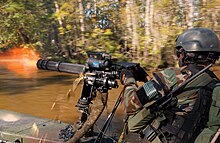
A multiple-barrel firearm is any type of firearm with more than one gun barrel, usually to increase the rate of fire or hit probability and to reduce barrel erosion/overheating. [1]
History[]
Volley gun[]

Multiple-barrel firearms date back to the 14th century, when the first primitive volley guns were developed.[2] They are made with several single-shot barrels assembled together for firing a large number of shots, either simultaneously or in quick succession. These firearms were limited in firepower by the number of barrels bundled, and needed to be manually prepared, ignited and reloaded for each firing.
In practice the large volley guns were not particularly more useful than a cannon firing canister shot or grapeshot. Since they were still mounted on a carriage, they could be as hard to aim and move around as a heavy cannon, and the many barrels took as long (if not longer) to reload.[3] They also tended to be relatively expensive since they were structurally more complex than a cannon, due to all the barrels and ignition fuses, and each barrel had to be individually maintained and cleaned.
Pepperbox[]
A pepper-box gun or "pepperbox revolver" has three or more barrels revolving around a central axis, and gets the name from its resemblance to the household pepper shakers. It has existed in all ammunition systems: matchlock, wheellock, flintlock, snaplock, caplock, pinfire, rimfire and centerfire. They were popular in North America from 1830 until the American Civil War, but the concept was introduced much earlier. After each shot, the user manually rotates a next barrel into alignment with the hammer mechanism, and each barrel needs to be reloaded and maintained individually.
In the 15th century, there were design attempts to have several single-shot barrels attached to a stock, being fired individually by means of a match. Around 1790, pepperboxes were built on the basis of flintlock systems, notably by Nock in England and "Segallas" in Belgium. These weapons building on the success of the earlier two-barrel turnover pistols, were fitted with three, four or seven barrels. These early pepperboxes were manually rotated.[4]
The invention of the percussion cap building on the innovations of the Rev. Alexander Forsyth's patent of 1807 (which ran until 1821), and the Industrial Revolution allowed pepperbox revolvers to be mass-produced, making them more affordable than the early handmade guns previously only seen in possessions of the rich. Examples of these early weapons are the American three-barrel Manhattan pistol, the English Budding (probably the first English percussion pepperbox) and the Swedish Engholm. Most percussion pepperboxes have a circular flange around the rear of the cylinder to prevent the capped nipples being accidentally fired if the gun were to be knocked while in a pocket, or dropped and to protect the eyes from cap fragments.
Samuel Colt owned a revolving three-barrel matchlock musket from British India,[5] and an eight-barrel pepperbox shotgun was designed in 1967 but never went into production.
Derringer[]
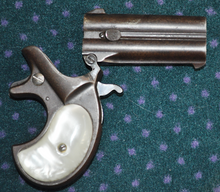
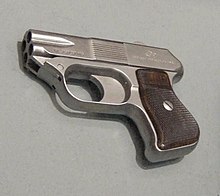
The original Philadelphia Deringer was a small single-barrel, muzzleloading caplock pistol designed by Henry Deringer (1786–1868) and produced from 1852 to 1868, and was a popular concealed carry single-shot handgun of the era widely copycatted by competitors.[6] However, it was the breechloading over-and-under Remington Model 95, manufactured by Remington Arms from 1866 to 1935,[7][8] that has truly achieved widespread popularity to the point that it completely overshadowed all other designs and becoming synonymous with the word "derringer". It used a break action design with two single-shot barrels chamber for the .41 rimfire cartridge, and a cam on the hammer alternated between the barrels. The Remington derringer design is still being manufactured today by American Derringer, Bond Arms and Cobra Arms,[9] and used by Cowboy Action Shooting reenactors as well as a concealed-carry weapon.
The Sharps Derringers were four-barrel derringers with a revolving firing pin (often called the "Sharps Pepperbox" despite not of a revolving-barrel design) first patented in 1849,[10] but were not made until 1859 until Christian Sharps patented a more practical design. When loading and reloading, the four barrels slide forward open the breech. Production of these came to an end with the death of Christian Sharps in 1874.
Modern derringer designs are almost all multi-barrelled, essentially making them handheld compact volley guns. The COP 357 is a .357 Magnum-caliber four-barrel (2×2), double-action hammerless derringer introduced in 1984, and not much larger than a .25 ACP semi-automatic pistol. A smaller-caliber .22 Magnum "Mini COP" was also made by American Derringer.
The .45 ACP DoubleTap derringers double-barreled (over-under), double-action hammerless derringers introduced by DoubleTap Defense in 2012.[11] The name comes from the double tap shooting technique, in which two consecutive shots are quickly fired at the same target before engaging the next one.[12] These derringers also hold two extra rounds of cartridge in the grip, allegedly drawing inspiration from the FP-45 Liberator pistol.[13]
Double-barreled shotgun[]
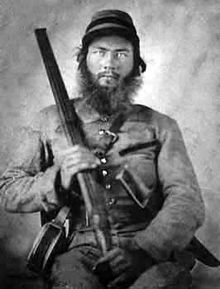
By 1790, Joseph Manton, acknowledged as the “father of the modern shotgun”, first brought together all the facets of the contemporary flintlock shotguns into the form of the modern double-barreled shotguns. Soon, caplock ignition replaced flintlock, and then rather quickly, was replaced by the self-contained shell cartridge.[14]
During the 19th century, shotguns were mainly employed by cavalry units, as mounted units favored its moving target effectiveness, and devastating close-range firepower. Both sides of the American Civil War employed shotguns, and the U.S. Cavalry used them extensively during the Indian Wars. Shotguns also remained popular with citizen militias, guards (e.g. the shotgun messengers) and lawmen as a self-defense weapon, and became one of the many symbols of the American Old West.
In 1909, Boss & Co. introduced the over-and-under shotgun,[14] which has remained the more popular configuration for double-barreled shotguns. Nowadays the pump-action and semi-automatic shotguns have taken over most roles in civilian home defense, law enforcement and military usages, though the over-and-under shotguns still remain popular for waterfowl/upland hunting and clay pigeon shooting.
Rotary gun[]
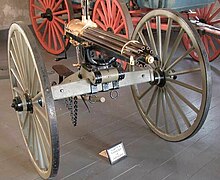
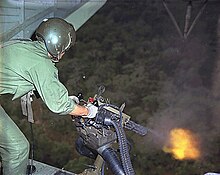

The Gatling gun is one of the best-known early rapid-fire weapons and a forerunner of the modern machine guns and automatic rotary guns. Invented by Richard Gatling, it saw occasional use by the Union forces during the American Civil War in the 1860s, which was the first time it was employed in combat. Later, it was used again in numerous military conflicts, such as the Boshin War, the Anglo-Zulu War, and the assault on San Juan Hill during the Spanish–American War.[15] It was also used by the Pennsylvania militia in episodes of the Great Railroad Strike of 1877, specifically in Pittsburgh.
The Gatling gun's operation centered on a pepperbox-like multi-barrel assembly whose design facilitated better cooling and synchronized the firing-reloading sequence. The gun was operated by manually turning a crank-like side-handle, which was geared to rotate the entire barrel assembly. Each barrel is coupled to a cam-driven bolt, which picked up a single cartridge and then fired off the shot when reaching certain positions in the rotation, afterwards it ejected the spent cartridge case and allowed the empty barrel to cool somewhat before loading a new round and repeating the cycle. This cyclic configuration overlapped the operation of the barrel-action groups, and allowed higher rates of fire to be achieved without each barrel overheating.
Richard Gatling later replaced the hand-cranked mechanism of a rifle-caliber Gatling gun with an electric motor, a relatively new invention at the time. Even after he slowed down the mechanism, the new electric motor-powered Gatling gun had a theoretical rate of fire of 3,000 rounds per minute, roughly three times the maximum rate of a typical modern single-barreled machine gun. Gatling's electric-powered design received U.S. Patent #502,185 on July 25, 1893,[16] but despite the improvements, Gatling guns soon fell into disuse after cheaper, lighter-weight and more reliable recoil- and gas-operated machine guns were invented; Gatling himself went bankrupt for a period.[17]
During World War I, several German companies were working on externally powered guns for use in aircraft. Of those, the best-known today is perhaps the Fokker-Leimberger, an externally powered 12-barrel rotary gun using the 7.92×57mm Mauser rounds; it was claimed to be capable of firing over 7,000 rpm, but suffered from frequent cartridge-case ruptures[18] due to its "nutcracker", rotary split-breech design, which is fairly different from that of a Gatling.[19] None of these German guns went into production during the war, although a competing Siemens prototype (possibly using a different action) which was tried on the Western Front scored a victory in aerial combat.[18] The British also experimented with this type of split-breech during the 1950s, but they were also unsuccessful.[20]
In the 1960s, the United States Armed Forces began exploring modern variants of the electric-powered, rotating barrel Gatling-style weapons for use in the Vietnam War. American forces in the Vietnam War, which used helicopters as one of the primary means of transporting soldiers and equipment through the dense tropical jungles, found that the thinly-armored helicopters were very vulnerable to small arms fire and rocket-propelled grenade (RPG) attacks when they slowed to land. Although helicopters had mounted single-barrel machine guns, using them to repel attackers hidden in the dense jungle foliage often led to barrels quickly overheating or the action jamming.[21][22]
In order to develop a weapon with a more reliable, higher rate of fire, General Electric designers scaled down the rotating-barrel 20 mm M61 Vulcan rotary cannon for the 7.62×51mm NATO ammunition. The resulting weapon, the M134 Minigun, could fire up to 6,000 rounds per minute without overheating. The gun has a selectably variable rate of fire specified to fire at rates of up to 6,000 rpm, with most applications set at rates between 3,000-4,000 rounds per minute.
The Minigun was mounted on Hughes OH-6 Cayuse and Bell OH-58 Kiowa side pods; in the turret and on pylon pods of Bell AH-1 Cobra attack helicopters; and on door, pylon and pod mounts on Bell UH-1 Iroquois transport helicopters. Several larger aircraft were outfitted with Miniguns specifically for close air support: the Cessna A-37 Dragonfly with an internal gun and with pods on wing hardpoints; and the Douglas A-1 Skyraider, also with pods on wing hardpoints. Other famous gunship aircraft were the Douglas AC-47 Spooky, the Fairchild AC-119 and the Lockheed AC-130.[22]
See also[]
- Combination gun – Type of firearm with at least one rifled barrel and one smoothbore barrel
- Double-barreled cannon – American Civil War cannon
- Double-barreled shotgun – Shotgun with two parallel barrels
- List of firearms – Wikimedia list article
- List of multiple-barrel firearms – Wikipedia list article
- Multiple rocket launcher – Rocket artillery system capable of launching multiple rockets in quick succession
- Small arms
References[]
- ^ Suciu, P. (2020, December 18). The M61 minigun is a gatling gun on steroids. The National Interest. Retrieved October 30, 2021, from https://nationalinterest.org/blog/reboot/m61-minigun-gatling-gun-steroids-174655.
- ^ "HyperWar: The Machine Gun (Vol. /Part )". Ibiblio.org. Retrieved May 15, 2015.
- ^ Matthew Sharpe "Nock's Volley Gun: A Fearful Discharge" American Rifleman December 2012 pp.50-53
- ^ The new weapons of the world encyclopedia: An international encyclopedia from 5000 B.C. to the 21st century by Diagram group, (Macmillan, 2007) p.126
- ^ Cooper, C, Samuel Colt: Arms, Art, and Invention (2006) p.26
- ^ Russell, Carl Parcher (1980). Guns on the Early Frontiers: A History of Firearms from Colonial Times Through the Years of the Western Fur Trade. Omaha: U of Nebraska Press. pp. 138–139. ISBN 0-8032-8903-0.
- ^ "Remington .41 Double Derringer". American Rifleman. March 24, 2014. Retrieved 2017-07-22.
- ^ Marcot, Roy M. (2005). The History of Remington Firearms. Lyons Press. p. 32. ISBN 978-1-59228-690-4.
- ^ Ramage, Ken (2008). Gun Digest 2009. Iola, Wisconsin: F+W Media, Inc. p. 308. ISBN 978-0-89689-647-5.
- ^ David Chicoine (2005). Guns of the New West: A Close Up Look at Modern Replica Firearms. Krause Publications. p. 23. ISBN 978-0-87349-768-8.
- ^ S., Jeremy (2013-07-01). "Gun Review: DoubleTap Tactical Pocket Pistol". The Truth About Guns. Retrieved 2016-09-05.
- ^ "Frequently Asked Questions". Heizer Defense LLC. Archived from the original on 14 October 2012. Retrieved 22 December 2012.
- ^ "Announcement". Heizer Defense LLC. 7 November 2012. Retrieved 22 December 2012.
- ^ a b Taylor, John M. (2016-05-23). "Looking Back at Shotgun History". American Rifleman. Retrieved 2020-10-27.
- ^ Chambers, John W. (II) (2000). "San Juan Hill, Battle of". The Oxford Companion to American Military History. HighBeam Research Inc. Archived from the original on 2009-11-26. Retrieved 2009-11-24.
- ^ "U.S. Patent 502185 Gatling Gun". Retrieved February 4, 2010.
- ^ Chivers, C. J. (2010). The Gun. Simon & Schuster. pp. 116–119. ISBN 978-1-4391-9653-3.
- ^ a b Weyl, A. R. (8 March 1957). "Motor-guns—a Flashback to 1914-18". Flight. 71 (2511): 313–314. Retrieved 30 September 2015.
- ^ Williams, Anthony G. (8 November 2005). "Split Breech Guns: The Nutcracker and the 40mm Mk 18". Archived from the original on 14 June 2007.
- ^ Williams, Anthony G.; Gustin, Emmanuel (2005). Flying Guns of the Modern Era. Crowood. p. 55. ISBN 978-1-86126-655-2.
- ^ "General Electric M134 Minigun Six-Barrel Gatling Gun".
- ^ a b Jarvis, John Paul. "Brought to You By GE: The M134 Minigun". Archived from the original on 2012-02-19. Retrieved 2018-11-21.
- Firearm actions
- Multiple-barrel firearms